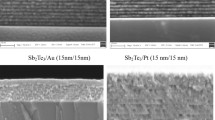Abstract
This study investigates the thermoelectric (TE) power factor for radiofrequency (RF)-sputtered n-type ZnO:Al/ZnO:(Al,In) multilayer quantum wells (QW) and the dependence on band-gap offset at high operating temperatures. The structures are 50 periods of 10-nm-thick barrier and well layers. The TE power factors for all films are promising (>20 × 10−4 W/m2 K); however, a decline in electronic transport is evident for each of the doped wells over a specific range of operating temperatures. This supports the need for optimum doping levels for a specific operating temperature range; e.g., 2 at.%, 5 at.%, and 8 at.% indium are optimum at 300 K to 600 K, 600 K to 725 K, and >725 K, respectively. A model has also been developed to calculate the QW electronic transport as a function of temperature and band-gap offset, which is subsequently related to doping concentration. This model confirms a loss in electrical conductivity due to charge carriers gaining enough kinetic energy to overcome the QW barrier, which results in multilayer hopping across well–barrier interfaces. In addition, film microstructure and interface roughness have been determined by x-ray and spectroscopy techniques.
Similar content being viewed by others
References
M.A. Kuroda and J.P. Leburton, Phys. Rev. Lett. 101, 256805 (2008).
T. Hendricks and W. Choate, US DOE, Industrial Technologies Program (2006).
T.C. Harman, M.P. Walsh, B.P. LaForge, and G.W. Turner, J. Electron. Mater. 34, L19 (2005).
L.D. Hicks and M.S. Dresselhaus, Phys. Rev. B 47, 12727 (1993).
R. Venkatasubramanian, Phys. Rev. B 61, 3091 (2000).
G.H. Dohler, Phys. Scr. 24, 430 (1981).
C. LaBounty, A. Shakouri, and J. Bowers, J. Appl. Phys. 89, 4059 (2001).
C.A. Howells, C. Watkins C, and R. Venkatasubramanian, ASME, 2nd Int. Conf., ES50462, Jacksonville, FL (2008).
J.C. Caylor, K.D. Coonley, J.R. Stuart, T. Colpitts, and R. Venkatasubramanian, Appl. Phys. Lett. 87, 023105 (2005).
M. Ohtaki, K. Araki, and K. Yamamoto, J. Electron. Mater. 38, 1234 (2009).
S. Teehan, H. Efstathiadis, and P. Haldar, J. Alloy. Compd. 509, 1094 (2011).
A.V. Wagner, R.J. Foreman, L.J. Summers, J.C. Farmer, and T.C. Barbee Jr., Int. Conf. Thermo. Proc., Philadelphia, PA (1997), p. 465.
N.B. Elsner and S. Ghamaty, Int. Conf. Thermo., Pasadena, CA (1996).
Parratt, Phys. Rev. 95, 359 (1954).
K.C. Je and C.H. Cho, J. Korean Phys. Soc. 54, 105 (2009).
G. Chen, IEEE Trans. Component Packag. Technol. 29, 238 (2006).
M. Mazumder, T. Borca-Tasciuc, S. Teehan, E. Stinzianni, H. Efstathiadis, and S. Solovyov, J. Appl. Phys. 96, 093103 (2010).
C.B. Vining, J. Appl. Phys. 69, 331 (1991).
G.P. Agrawal and N.K. Dutta, Semiconductor Lasers, 2nd ed. (New York: Springer, 1993).
Author information
Authors and Affiliations
Corresponding author
Rights and permissions
About this article
Cite this article
Teehan, S., Efstathiadis, H. & Haldar, P. Thermoelectric Performance of ZnO:Al/ZnO:(Al,In) Quantum Well Multilayer Structures as a Function of Indium Composition and Band-Gap Offset at High Operating Temperatures. J. Electron. Mater. 41, 1831–1837 (2012). https://doi.org/10.1007/s11664-012-2084-8
Received:
Accepted:
Published:
Issue Date:
DOI: https://doi.org/10.1007/s11664-012-2084-8



